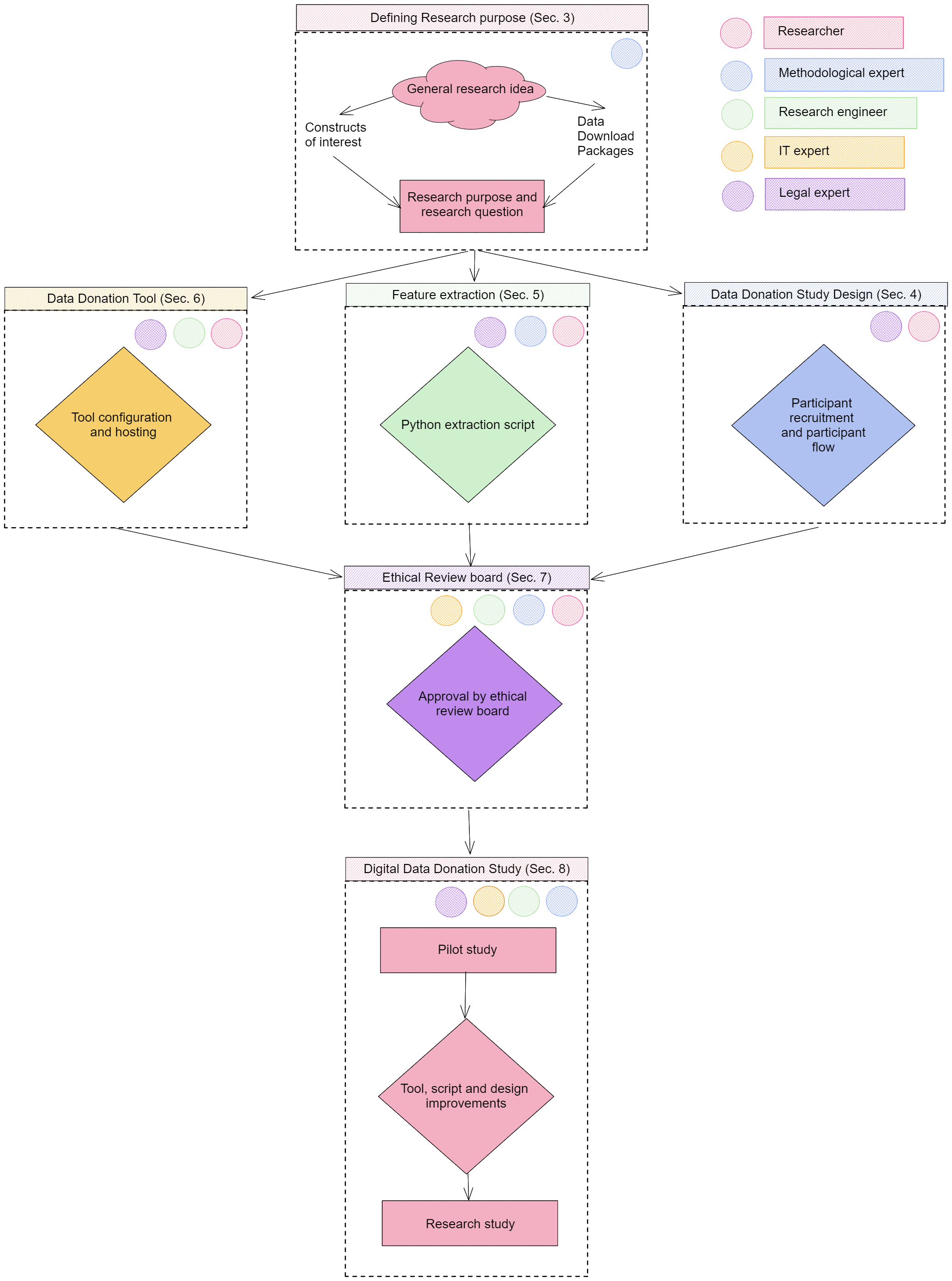Workflow
Introduction
The following text is a summary of the paper published by Carrière et al. (2023).
In case you make use of this, please cite:
Carrière, T. C., Boeschoten, L., Struminskaya, B., Janssen, H., de Schipper, N. C., & Araujo, T. (2024). Best practices for studies using digital data donation. Quality & Quantity. https://doi.org/10.1007/s11135-024-01983-x
The workflow we designed for data donation studies is shown in Figure 1. In this section, we first provide a brief overview of the proposed workflow. Next, different domains of expertise are identified for the workflow. At last, illustrative research questions are introduced to guide the more detailed discussion of the workflow in the following sections.
A data donation study starts with a research idea or topic where data donation is considered to be of added value. This research idea becomes more specific by identifying DDPs of relevant platforms and operationalizing how constructs of interest can be measured from those. Then, the workflow continues with (simultaneously) preparing the three core elements of the data donation study:
- The study design.
- The feature extraction script.
- Configuration of the data donation tool.
Next, the study can be submitted to an ethical review boar (ERB). After approval of the ERB, it is advised to conduct a pilot study prior to starting the full data donation study, such that all study elements can be tested and improved accordingly.
Figure 1

Domain experts
In order to successfully prepare a data donation study, unique knowledge and expertise from several different domains are required. We identified five domains of expertise deemed relevant for data donation studies, represented by different roles:
- An applied researcher with a substantive research question to be answered using data donation is involved in all steps. They carry primary responsibility for the study.
- An expert in the field of methodology can help to design the study in such a way that potential bias in outcomes as a result of the study design are minimized.
- A research engineer can develop the script that extract relevant features from the DDPs of interest.
- An IT expert can configure the server which hosts the study and data storage.
- An expert on legal, privacy and ethical issues can be consulted at various steps of the study workflow to ensure legal and ethical standards are met. In Figure 1, it is summarized what domain experts are involved in each step of the workflow.
Illustrative research questions
To illustrate the workflow and possible challenges that can arise at each step, three example research questions that can be answered with the use of data donation are used. These research questions vary in their level of processing of the extracted data prior to donation. The first research question is based on the study by Struminskaya (2022). Struminskaya et al. investigated data donation in a Dutch non-probability panel, concerning travel data. Data on the number of kilometers and hours traveled was extracted from Google Semantic Location History (GSLH) DDPs and processed to aggregate statistics, using Port. The illustrative research question based on this study is the following:
RQ1: Did travel behaviour in the Dutch population change during Covid-19?
The second example research question is based on a study by Theo Araujo, investigating algorithmic profiling by social media platforms using a first iteration of D3I. The study extracted the inferred interest of participants as raw data from DDPs. The research question following from this example is:
RQ2: What interests do social media platforms infer from their users, and how do these differ over platforms?
The last example research question is based on the data donation study by Corten et al. (2022), studying behaviour of participants ofWhatsApp groups. The study extracted data from two different WhatsApp DDPs, and used the local processing of Port to aggregate these data. This last research question is:
RQ3: What are the social network structures in group chats?